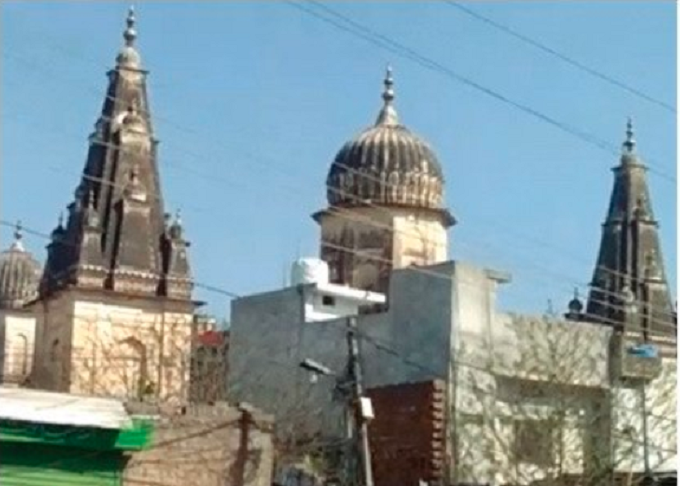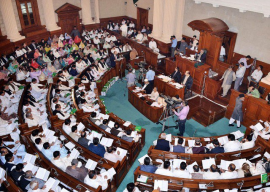
The ancient city of Rawalpindi was home to several Hindu temples and Sikh gurdwaras over a century and a half ago as it was a majority Hindu and Sikh city before the Partition of India in 1947, while Muslims made up 43.79% of the population.
With the passage of time and the increased growth in population, the city’s demography gradually changed. Most of the old and historic places fell victim to the advent of modernisation. Consequently, the names of historical temples and gurdwaras have vanished from modern-day Rawalpindi.
At present, the total population of the garrison city has increased to 5,465,000 whereas from 1880 to 1947, its population was between 100,000 to 300,000.
During that time, there were, in total, 10 temples and three gurdwaras in the garrison city. But today, unfortunately, all three gurdwaras have vanished while only one Hindu temple is left for worship.
There are traces, ruins and dilapidated structures of the remaining nine temples, but due to the best Mughal and European architecture, the grandeur of these ruined temple buildings, strong structures, carvings of deities and idols on the walls, paintings, ventilated windows and traces of strong wooden doors seem to show the elegance of the architecture.
The Hindu community usually worships at the Krishna Mandir located between the Rawalpindi Railway Station and Kabari Bazaar in Saddar and the ancient and small Maharishi Valmik Swamiji Mandir in Gracy Lines.
The Hindu families from all over the city, cantonment and Islamabad come to worship at the Krishna Mandir. This is the only temple where bells are rung for daily worship.
The oldest temple in Rawalpindi was in the Purana Qila, the most expensive commercial area of the city. It was called Guru Balmik Swamiji's Mandir. This was the temple where a fair was held every year in June and Hindus from all over the subcontinent used to worship here. Its ruins are still visible. It was built in 1880. It was a magnificent triple-story temple. Its valuable wood was stolen and shops were built here.
The second oldest temple was Bagh Sardaran Mandir, which was built in 1895. This area was the centre of Hindus and Sikhs at that time while there were only a few Muslim families.
Hindus and Sikhs were wealthy families here who owned private businesses. They had large grocery shops here. This temple still exists today. The Mughal-style building still exudes grandeur.
There was also a big central gurdwara for the Sikhs. Its building is also there. The building of this gurdwara is occupied by the Special Branch of Police. The special branch offices and a large investigation centre are established here. Its minarets are also visible from a distance.
The third major temple is the Shri Krishna Temple near the railway station in Kabari Bazar Sadar. It was built in 1897. It was built by Hindu businessmen Kanji Mal and Ujagar Mal Ram Rachpal.
This temple is also in a dilapidated condition. A grant of Rs20 million has now been announced by the government for its renovation. However, no funds have been released so far.
There was a Ganesh temple in the Hindu locality of Asghar Mall, which has now turned into a garbage dump and shopkeepers have occupied its premises.
The Mohan Mandir in Lunda Bazar was built in 1930. Here the mosque and the temple were built side by side. This temple is still standing today but worship is not carried out here.
Kalidas Mandir and Shiv Mandir are in Ganjmundi Cantt Area. Both these temples are also in dilapidated condition and have turned into nesting places for bats.
Kalyan Das Temple is located in Kohati Bazar. This temple was built in 1928. This temple is under the control of the Education Department. There is a government high school for special children and a government sewing and embroidery centre here.
In December 2021, the Pakistan Tehreek-e-Insaf (PTI) government launched a project to renovate and restore the seven destroyed and abandoned temples of Rawalpindi including the Shiv Mandir, Mohan Mandir, Bagh-e-Sardaran Mandir, Ganesh Mandir, Kalidas Mandir and Bohar Bazar Mandir.
The project was estimated to cost Rs50 million. The funds were released and the contract was to be auctioned, but due to the alleged corruption in the Rawalpindi Ring Road project and the political uproar in Punjab, the project was first delayed and later cancelled.
The administrative control of these temples was to be given to the Department of Waqf Properties and the control of worship to the Hindu community after fully renovating these temples and all these temples were to be opened for tourism.
Bhabra Bazar and Lunda Bazaar temples. The premises of these temples which were cleaned earlier are now again covered with dust and they have become the habitats of bats, stray dogs, cats and rats. Whereas in Bagh-e-Sardaran and Bhabra Bazar Mandi, addicts are seen smoking heroin-filled cigarettes.
Hindu Welfare Society President Heera Lal says that an amount of Rs20 million was announced for the decoration of Krishna Mandir. “The money was never given to us and we are doing the repairs on our own,” he said and demanded that the assets of all the destroyed temples should be preserved as archaeology and preservation of the ancient culture of Rawalpindi.
Published in The Express Tribune, January 23rd, 2023.


1731573461-0/BeFunky-collage-(57)1731573461-0-165x106.webp)
1722585575-0/BeFunky-collage-(22)1722585575-0-165x106.webp)
1731572852-0/emily-(2)1731572852-0-165x106.webp)

1731562710-0/Untitled-design-(3)1731562710-0-270x192.webp)



1726722687-0/Express-Tribune-Web-(9)1726722687-0-270x192.webp)







COMMENTS
Comments are moderated and generally will be posted if they are on-topic and not abusive.
For more information, please see our Comments FAQ